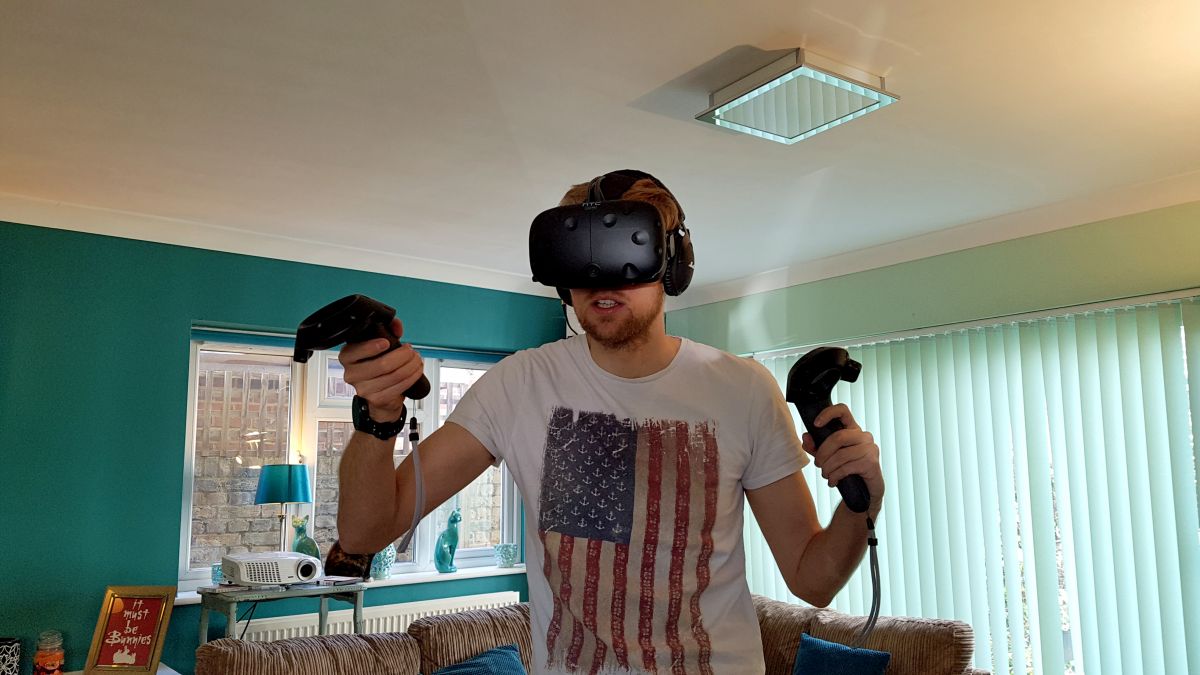
The long, long set-up
I sat there, staring at my desktop PC. It’s too old to run VR, I was sure of that – it’d be getting ready for its first day of high school were it a child.
I came to the conclusion that I’d probably only have to upgrade the motherboard, CPU and graphics card. And power supply. And other unknown elements… and that I have no idea how to do those things. I wasn’t going to be able to buy my own VR headset any time soon.
I sighed, and turned back to the front door, willing the delivery company to come and bring my demo HTC Vive unit (and VR-capable PC that I smartly borrowed from Nvidia). It took HOURS.
You see, ever since I tried the Vive in Barcelona at the start of 2015, I was hooked. I wanted to have one of my very own to play with ever since, not bound by the short demonstrations I’ve been unable to choose. It was a long 13 months.
It’s testament to the potential of the tech that I was still excited that long after the first trial – most things would have been usurped and something far more brilliant found. But that’s why I, a categorical non-gamer, was waiting near the door like a frenzied hound, expectant of his master’s footsteps.
I hate admitting that I’m a non-gamer. I grew up with Nintendo, whiling away hours trying to defeat Bowser in various guises. One of my pervading memories from childhood is the excitement and frustration of having to wait a whole night to tell my best friend I’d completed Super Mario Bros. 3.
So to admit to you that in my adult life that, despite owning all iterations of the PlayStation, I rarely use my console for anything other than streaming Netflix and playing Blu-rays is very difficult.
But with the advent of VR I had high hopes that stirring would re-emerge, that I’d suddenly find the time that was inexplicably robbed from me every day to ‘get around to playing’.
This was it. I had four days over the long weekend with the Vive and I was going to do something crazy: spend 12 hours straight in the VR experience. I was going to have all amenities ready (or within ‘shut my eyes and stumble’ reach) and I was going be so immersed in the VR world that I might go full Lawnmower Man.
This wasn’t going to be a review – after all, I was trying the Vive Pre for developers, not the final edition. This is an experiential look.
The knock comes. FINALLY it was here – and wow, it’s huge. I expected the monolithic box for the PC, but the Vive came with something equally as big. I suppose the headset, controllers, link box and infra red sensors all do add up to quite a lot of space… but I wasn’t expecting that.
I carefully took it all apart and lay it on the floor of my lounge, knowing full well I’d have to reassemble it in four days time.
With the computer added into the mix, there are a lot of wires and connections to figure out. There’s also something ‘hilarious’ about a PC being in a living room… to me, they’re supposed to be in the study or tucked under the stairs. This is mind-blowing stuff.
At least putting together the PC is the easy bit, with a few plugs seeing me up and running with the scarily powerful rig. Then came the part that slowed me right down: actually setting up the Vive.
First of all, I realized I needed to get the infrared sensors in the right place. The box came with wall mounts, but drilling in for a few days seemed a bit excessive (and I’m still in trouble from accidentally mounting the TV in the wrong place and having to do it again…).
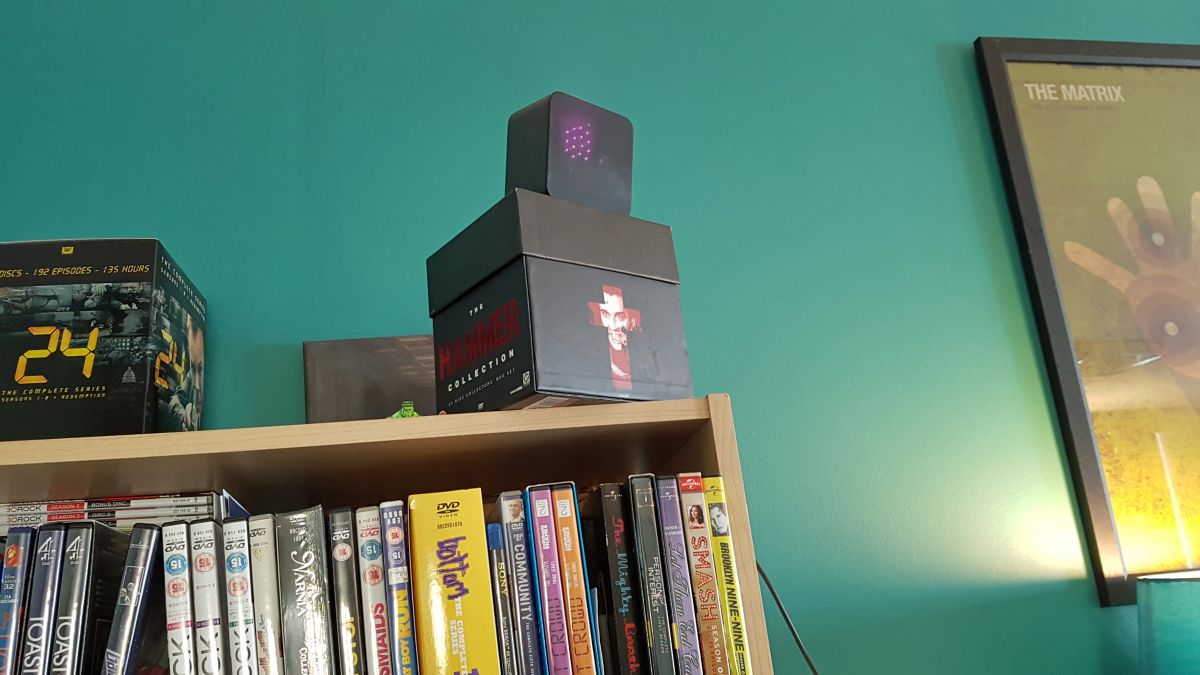
They somehow needed to go higher than head height somehow. That’s limiting, and I scanned around my room. There was a bookcase that would work, but nothing on the other side of the room… Hmmm. One moved lamp later, and expensive technology was balanced precariously on top of something I inherited from my university house.
With the power leads attached the sensor looked ridiculous, but it was the only way to make the experience work, as putting the sensors at a more sensible, less fragile height would later prove to not work as accurately.

I downloaded Steam, SteamVR (which I’ve heard of, but have never used before), set up an account and updated a few drivers. Whenever I see a request to make sure I’ve got drivers installed, I get a small cold sweat that takes me straight back to 1997 and attempting to make a minidisc player talk to my computer.
That was seven weeks of my life I’m not getting back.
But it did highlight a big question with VR: who’s it for right now? While not exactly arduous, putting together all this stuff needs someone who’s au fait with troubleshooting PC installations, as there’s so much that could go wrong here.
And go wrong it does. I do everything step by step: plug in the headset at the right time, connect the link box to USB at the right moment, and yet once it’s all up and running I still was told the headset isn’t connected. There’s a light blinking on the side, but nothing’s at home when looking through the goggle-holes. I panicked, worried I’ve got a defective unit.
I checked the installation in the Control Panel, and it says it failed. I don’t know why, and I can’t uninstall it. So I do what the troubleshooting box at the bottom of the page says and unplug it all and try again, which mercifully works.
However, our US team was trying to do the same thing with their Vive Pre and I get pinged a message asking ‘Hey, you run into issues setting up the Vive?’
No matter what we do, they can’t get it to start up – in the end, they needed to try a fresh PC. Vive installation isn’t easy. Fact.
Maybe this will be fixed with the consumer edition and HTC or Valve tweak up the software… but I’m not hopeful.
But I was in. The headset was showing lines. I could see the controllers in virtual space and the boxes floating in the corners. I WAS IN THE MATRIX.
I had a look at what software was available, and was surprised to find it was nearly all gaming – and the only one that wasn’t was Google’s TiltVR light painting app, which really is the same as a game, but just labelled software. There were no movies or theatrical experiences… Vive is clearly a gaming platform first and foremost.
I left as many games as I could downloading while I headed out for a run, and was pleased to see it all ready when I returned – my library of awesomeness was alive and my world would never be the same.
My living room is pretty clear, but I had to move a few tables out the way to properly make space before I could begin. However, I could see that if you needed to get the couch out of the playing space each time, this would be TEDIOUS.
I fired everything up, and was told to run the ‘room set up’ to get a sense of how far I could move around. When this involves having to use a mouse that’s on the carpet, it gets tedious pretty quickly, asking me to point controllers at the monitor, put things on the floor, calibrate this, move that, trace the outline of the playing space with another controller… there are five steps to go through and it’s a lot of clicking and moving things.
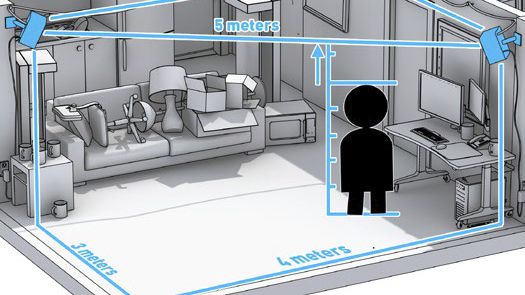
But it’s pretty straightforward, and once that was done I was actually in. I instantly went for The Blu, the underwater demo that lets you walk around the deck of a sunken ship while a blue whale swims on by.
It was the first demo I experienced of HTC Vive, and I wanted to see if I was still as enamored.
I utterly was. The grin was back on my face as I wandered the floor, bashing fish out of the way with my invisible hands and peering over the edge of the boat, looking down in the deep below before seeing the whale pop by.
No matter what happens, being able to walk in virtual space is something that’s so immersive. So completely absorbing that it’s like nothing I’ve tried before.
Except for one thing: we’re bound by our playing space. I’d cleared a pretty big arena to play in, and I consider 3m x 2.5m a pretty good amount of room – but even with that I quickly ran into the virtual green cage that pops up in game, slightly jarring the experience.
But it’s not terrible and you soon learn to use it as a soft guideline – and when Chaperone comes in properly (being able to use the front facing camera to bring the outside world gently into view when you’re getting to close to objects) it’s going to feel like second nature to drift between the two planes.
It was time for me to move on though and try some new games that I’ve not experienced before. I wanted to see how far things have progressed since I last tried the Vive.
First up, Ninja Trainer (which is really just Fruit Ninja in the VR world, and before long I’m flinging around my samurai sword at bits of fruit and trying to avoid bombs. It’s intensely irritating as I seem to be able to hit the target but then it won’t actually slice, just bouncing off into the ether.
Maybe I need to practice… but after two attempts I’m bored and am out of the game. Space Pirate Trainer… that sounds more like it.
And, my God, this WAS more like it. It’s a simple game of shooting at robots intent on shooting at me, but the second you look down at your hands, which have morphed into guns, and find a simple grab over your shoulder will pull out a shield… you’re in the next generation of gaming. Simple as that.
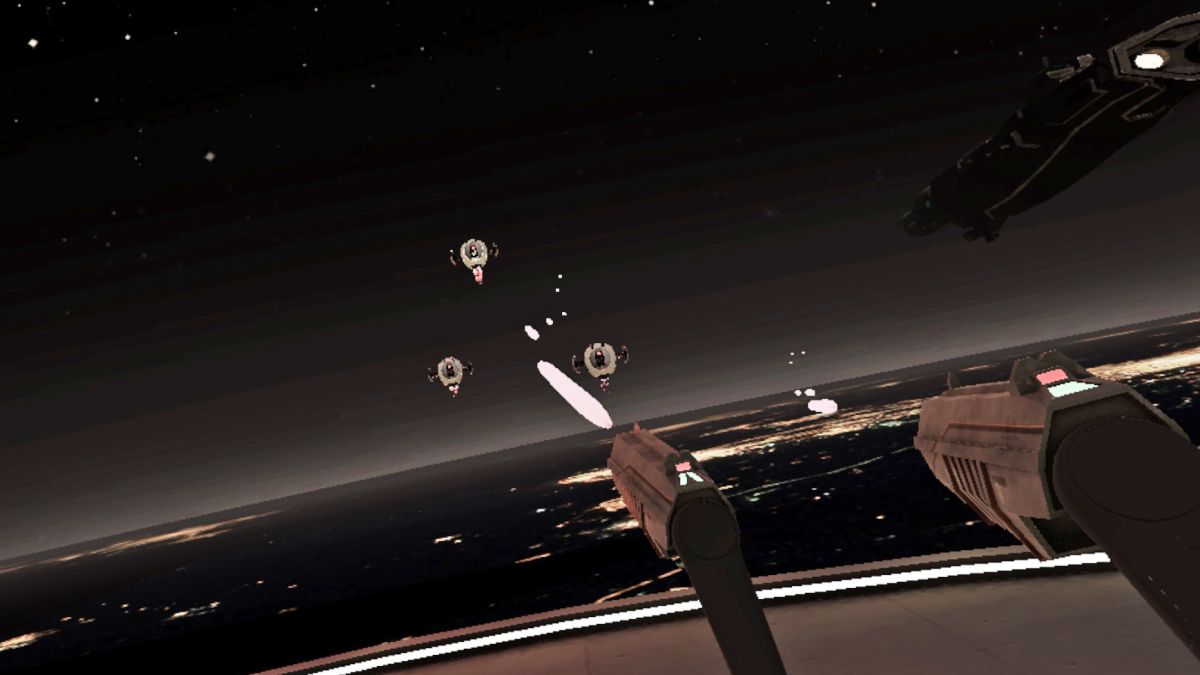
The robots started coming, and within about seven seconds I’d already started firing in all directions with my guns held sideways, like a proper badass. I was shooting left and right and pulling out my shield, crouching behind it and peering around the side to pop off a shot when the robots retreated briefly.
This is what VR gaming was supposed to be like, using actual ‘normal’ movements to play the game, and I was having the time of my life.
Except, well, nothing really changed. I shot some robots. Then more came. I shot them. More came. I died, and started at the beginning again.
Bar trying to get a higher score (which I couldn’t find out until the end of the game) there was no impetus to keep me playing, keeping me coming back for more.
I decided to change tack and try something else. A diorama game was cool (you needed to kneel down to look through a small hole and enter the mini worlds) and once in, you could walk around small worlds and even open a window and peer out – and with the audio shifting to represent the outside world, it was amazing to be able to interact in this way.
To compare this to my gaming origins, where making Mario bounce on a Goomba was mind-blowing, this was light years, alternate planes of existence ahead. It was reality… virtually.
But the diorama game was another example of how the potential was there, but the gameplay was lacking. There was nothing exciting to do… I was basically looking around a small room with a chair in the middle. Shrug.
Next up was minigolf, and this was pretty goddamn cool indeed. You held the putter and knocked the ball around the arena – it felt blindingly accurate and even the tap of the ball vibrating up the controller felt correct.
Obviously with minigolf you need to follow your ball, and this game just needed a pull on the trigger below the controller to teleport you to where your shot ended.
This was when I began to get a bit of motion sickness though, as combined with the slightly juddery graphics of this early demo it felt very alien. While I loved playing incredible courses (including getting a score of 22 on a par 4) the tiredness of gaming with this level of nausea quickly began to grate.
I was starting to tire, but there was one thing left I wanted to try: Sisters, a ‘horror game’, would be an intriguing experience given the immersion of the Vive.

I don’t watch horror films at the best of times, but I thought that I should summon up some courage and give it a try.
I lasted about 45 seconds. The combination of dark scenes and 3D audio meant I could barely think about anything else, petrified about what was coming from where I couldn’t see. A creepy doll, random noises… it was all too much. It was the first time I’d ever had goosebumps on my arms from fear.
I yanked off the headset for the first time… and then the bad feelings came. I can’t work out whether it was because I’d started the VR experience with sunshine pouring in through the windows and it was dark when I finished, or just the sheer level of immersion triggered something within me.
It left me feeling uneasy, a greasy anxiety that I couldn’t shake at all. There was something about this experience that jarred me badly, leaving me struggling to shrug off the feeling of being in the VR world.
It was the same feeling I experienced when I was playing Turok the Dinosaur Hunter on the Nintendo 64 – a trite thing to say when talking about an old video game, but the dark graphics and panic of not being able to find a save point before more adversaries jumped out the shadows left pubescent me feeling worried and panicked.
I calmed down after a few minutes, but a combination of the horror story and broken reality was enough to leave me feeling deeply uneasy for a while.
The rebirth of a gamer
Something weird happened a couple of hours later. I was making dinner – while still feeling cloaked in a background worry, I felt an itch I hadn’t experienced in years.
I wanted to play again. It was like being 14 years old, when I would get bored of something like Wave Race having played it for hours, then 45 minutes later wanting to play again.
I decided against it, but the urge gave me pause. If this experience was enough to float above the general terribleness of anxiety, there must be something in it. It was an intriguing enough feeling to make me determined to try again when a few minutes earlier I’d wondered if I was going to be able to complete this feature.
The next day I came down into the lounge, fresh and into the light of day. I’d spent the evening googling ‘VR anxiety‘ and while I’d found a wealth of information, it was all about the opposite experience to me.
People using virtual reality to overcome fears, or spend time floating in digital space to just calm their raw minds – but nothing on VR being a trigger.

I decided that, while I couldn’t stomach my original plan to play for 12 hours straight, some familiarity would make things different and trigger anything. Thankfully, I was right.
One of the nice things about jumping back into the experience was that I didn’t need to move things around, with only the infrared sensors needing to be shoved back into place. Having that playing area clear meant that I could just dive back in – and throughout my playing experience, even with cats roaming around, I failed to accidentally bash into one.
I did have to run the Room Setup again when I turned the PC back on… was I going to have to do this every time?
I fired up Space Pirate Trainer again, and I was having a great time. I quickly hit the same boredom when the waves of enemies became repetitive, but it was still great. I tried JeeboMan, which was a similar shoot-’em’up title but with multiple platforms and weapons to choose from, and it was much more immersive, asking me to move around the space to find an angle to attack from.
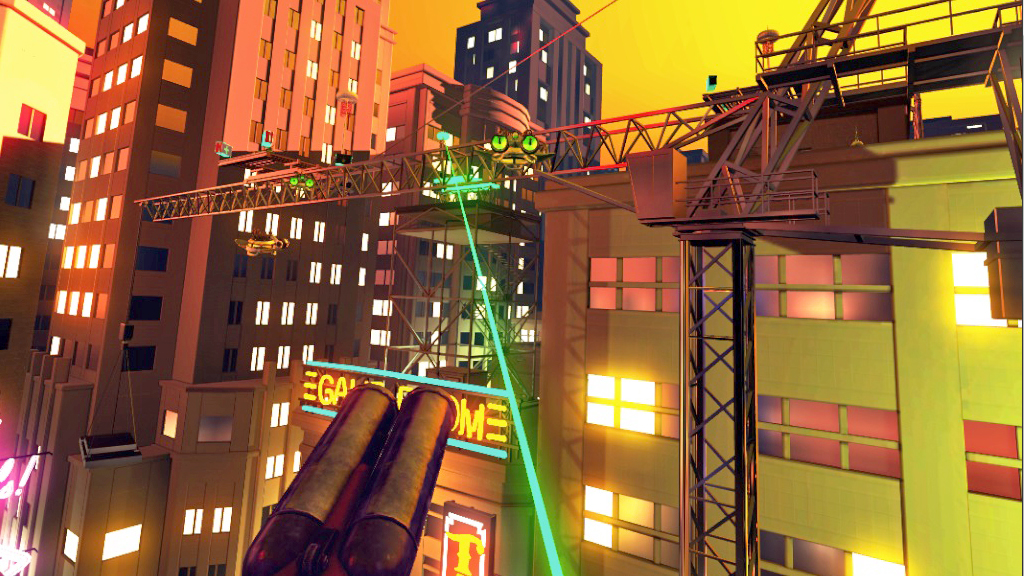
HordeZ, a zombie experience, also had multiple weapons and a variety of angles to attack from – with the game slowly moving me at walking pace through the halls in a way to counteract your inability to move far with Vive.
Each time I spent time getting to grips with the control system and playing the early levels through a couple of times to feel comfortable with what was going on, and it soothed me in a whole new way.
One of the interesting experiences I found in the middle of all the downloaded games was Gladiator, from 8i. This wasn’t a game, but a short movie with what sounded like a frat bro in the middle of an arena, about to take on a lion.
I thought I’d be able to hit him, but instead I could just walk around the space. He’d talk about different gates and experiences about to come, forcing me to change my gaze to see what he was talking about. It wasn’t that exciting (and was very short) but it showed a very different way to watch a movie.
Imagine if somehow this was possible in place of sitting a watching a real movie? Or a scene in something you were watching could be ‘Vive-enabled’ to give you a different perspective? It’s a much more active involvement, one that’s completely against the passive nature of usual couch-dwelling, but I was intrigued.
Then I finally experienced Fantastic Contraption, which I’d heard so much about but never got around to playing the day before. It was brilliant – building machines on the middle of a floating platform to either transport a balloon to another section or create a chain reaction that would get some pink things to hit other pink things, manipulating balloons, wood struts and wheels to make any device you want and set it rolling.
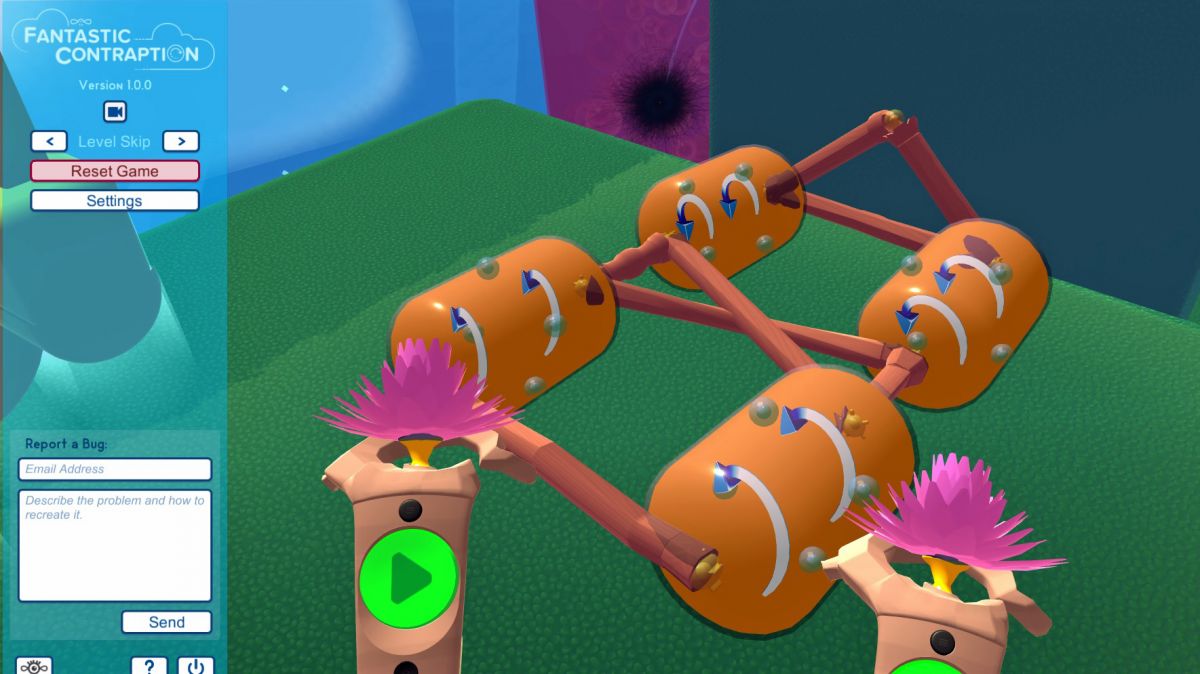
Trust me, it’s a lot better than it sounds. Even just being able to pick up a wood strut and throw it into space was more intuitive than anything I’ve ever played on a console.
But it was a lonely experience. I wished that other people could be there with me, helping me construct the device and offer suggestions when the thing I’d spent 15 minutes conceiving and creating just crumbled into a heap the second I tested it out.
So I decided to do the next best thing: call in some others to come and watch. I invited my fiancée and a few other friends into my VR holodeck (AKA the living room) and fired them through the same experiences: underwater with the whale, fighting space robots or building a massive contraption in space.
I learned three things quickly: firstly, it’s boring walking people through the VR set up, but amazing seeing their reactions for the first time. Secondly, people can’t really hear you when they’ve got the earphones on so you’ll need to shout. Thirdly, VR is actually an oddly social experience, despite only one person being able to experience the world.
Having a monitor that shows what they’re seeing really helps, and it’s really easy to imagine yourself in the same world as you see them traversing the space in real time.
The reactions varied from one person literally not being able to spend 10 seconds in the virtual world (‘No, I don’t like things like this!’) to someone being hooked on building devices in Fantastic Contraptions, ignoring the virtual walls, accidentally punching the TV and having to be (almost) wrestled away from the machine.
Then we tried the ultimate test: Sisters. I told everyone how frightening it was, but most had enough bravado to put on the headset and give it a go. But everyone, when the headphones went on, perceptibly changed and tensed.
It took us five attempts to complete the 4 minute demo (I’m proud to say I was the first to make it all the way to the end) as different shocks led to the headset being yanked off and screams emitting from the mouths of those using it.
This was immersion at its best / worst – and I can safely say I’ll not be buying the full game when it comes out (although I sadistically want to – it’s very well made).
When asked for their opinions on the Vive world, everyone was unified with the same result: immersive. Feeling totally lost in the new experience, and even when asked leading questions nobody mentioned once seeing a fuzzy pixel or that the digital cage broke the ‘fourth wall’ of the experience – and all of them loved the fact that being an object in the 3D sounds space felt awesome.
There were a few issues though, and they mostly revolved around the times when virtual reality didn’t mimic the real world fully enough.
For instance, the mini golf game put people in the wrong place outside the green, meaning some people didn’t know ‘where they were supposed to go’.
There was also universal derision of the touchpad on the controllers, which is located where your thumb rests. This is a clickable space where you can swipe your digit left or right to make selections, and for many games it was the way to select between guns, or for something like the 3D painting app TiltVR (by Google) a chance to interact with your brushes, colors and palettes.
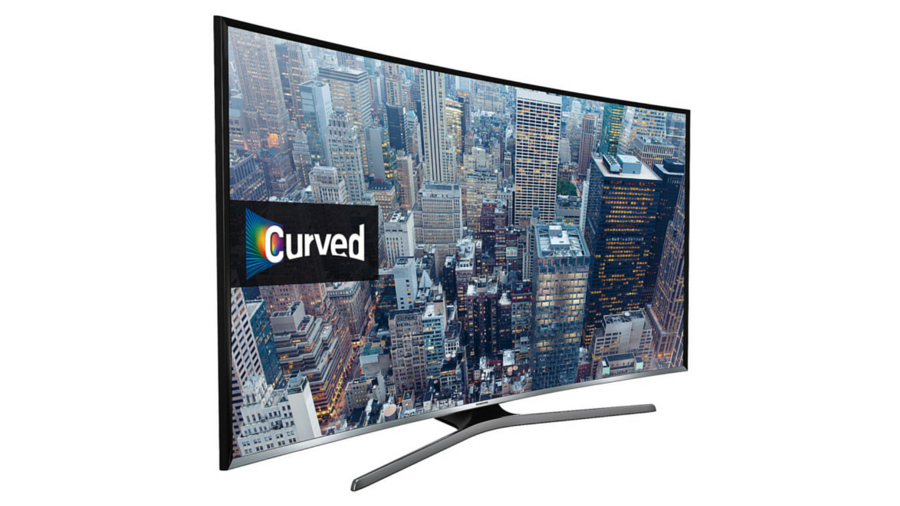
It just didn’t work. The accuracy under the finger was terrible, and the results meant that if you were in the heat of battle and needed to switch guns quickly, or just select a new section on the palette in TiltVR, it was impossible.
I hasten to stress that this isn’t the final review unit of the Vive and is subject to change before the retail version appears, but I’ll be surprised if this isn’t something that will take a long longer to correct.
That said, if I have to run that F***ING Room Setup every time I turn the computer on, I’ll lose my mind. I had to do it seven times, and it drove me insane.
There was also widespread dislike of the fact you need to be tethered to the PC, that everything is controlled by a large wire that protrudes out the back of your head and curled worryingly around your feet.

There was one instance where a frenzied move (oddly while someone was playing minigolf and not something that actually required violent motion) meant the cord was caught around someone’s foot and saw the headset being yanked out the back of the PC – thankfully not terminal, but not the kind of thing you want to see with such an expensive unit.
Let’s address the elephant in the room: I’ve tried to keep away from the price of the HTC Vive, because with the new PC that many will need and the cost of the headset, you’ll be spending at least £1500 (US $2000, AU$2500 ) to play a few games.
But that’s not what this piece is about, as I tried to explain to my best friend over the phone when he was asking about the Vive. He’s desperate to own virtual reality – he’s buying a Samsung phone simply to get a Gear VR – but can’t understand why anyone would pay £350 for a PlayStation VR, let alone the high price of the Oculus or Vive.
I found myself being a defender of VR, to explain that this isn’t the final product – it’s ground zero. It’s the beginning that everyone will laugh at in ten years time, when we’re all dancing around with tiny goggles or Bluetooth contact lenses, wireless buds in our ears and our phones powering the whole experience.
Because lest we forget a decade ago we didn’t even have the iPhone, and if you compare what emerged in Steve Jobs’ hands in 2007 to the iPhone 6S of 2015, it’s insane how far we’ve come. I can only hope that I get to read this piece in a decade and laugh at my prescience – and I’m proud of my first few days with VR.
In terms of out and out issues and glitches with the Vive, those listed above were pretty much it from everyone I spoke to, with everyone walking away breathless at the world they’d just seen.
Because that’s what this is. A whole new world, and with some parts of it, yes – you do actually have to be brave.
I have to be honest though. Even though I was tremendously sad to pack up the Vive and PC on the last day of the test (‘Maybe one more game of JeeboMan…?’) I still couldn’t foresee a time when I’d drop that much money on something that has a high chance of being consigned to the same cupboard as the Wii, a novelty that doesn’t tap away at me when I’ve got an idle moment to be played.
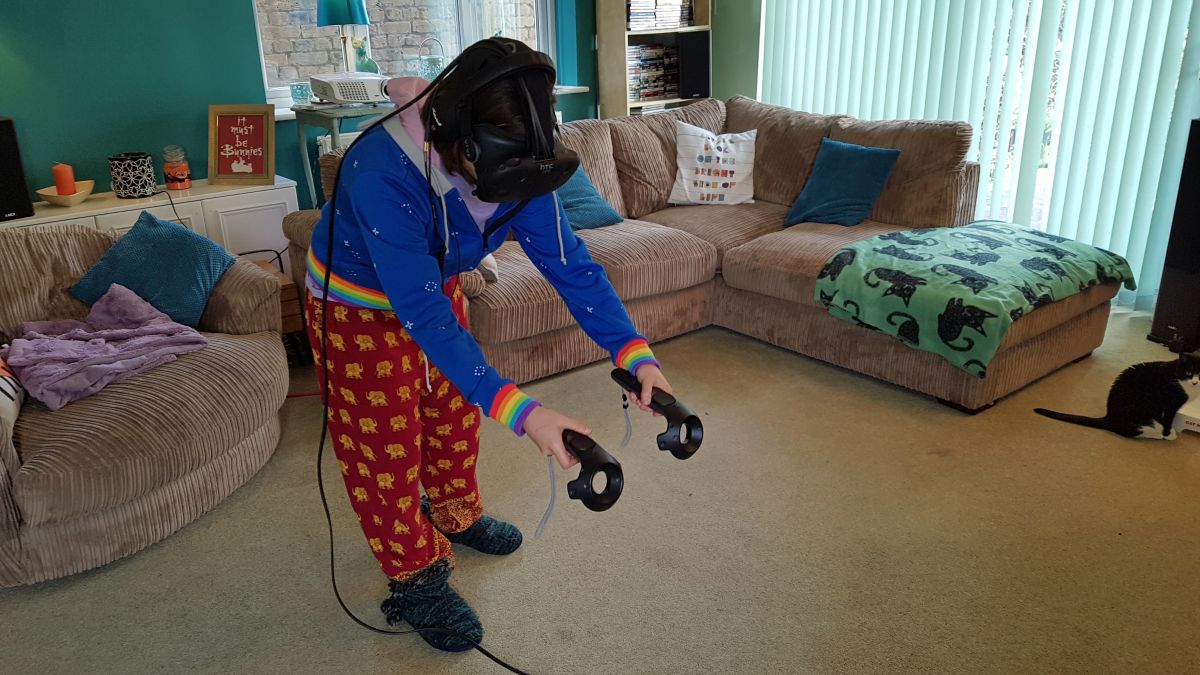
I’d hope that wasn’t the case. I’d like to believe when all the forthcoming games appear for the system that I could pay for a single title and play it through to completion every chance I get – but I know what I’m like, always intending to do leisure ‘projects’ but never getting around to them.
And that, for me, is what the HTC Vive (and VR in general) is all about – it’s something for the early adopter. The amount of sacrifice and setup (drilling into walls, tethers from the bulky headset, paying huge lumps of cash for the system) means VR is for those that want to experience the future at any cost, getting the new experience no matter what it needs.
And there are enough of those people out there, which is brilliant. There’s the momentum building, it seems, that VR will need to become consumer friendly in a few years’ time. And THEN I can countenance spending a few hundred dollarpounds on something I probably won’t play that much… But will keep meaning to.
Source: techradar.com










































^ that, maybe more subtly 😛
I don't understand how people can get a product like the Vive for 4 days and not do the slightest research for that.
The lighthouse stations are not infrared sensors. They are laser EMITTERS! And yes, they are responsible for the computer knowing the position of the headset and the controllers. Is it really that hard to grasp that you have to recalibrate every time that you move high precision equipment that tracks objects with a sub millimetre precision? I am also pretty sure that that is mentioned in the manual. RTFM!
People who own a Vive will screw the lighthouse stations to the wall or to a bookshelf. They will have to (re)calibrate very rarely.